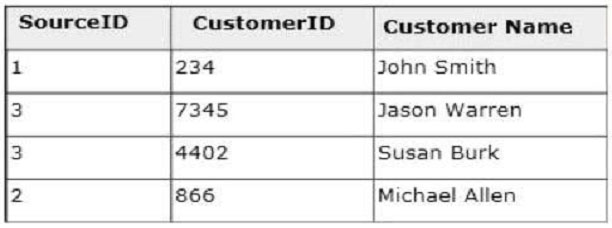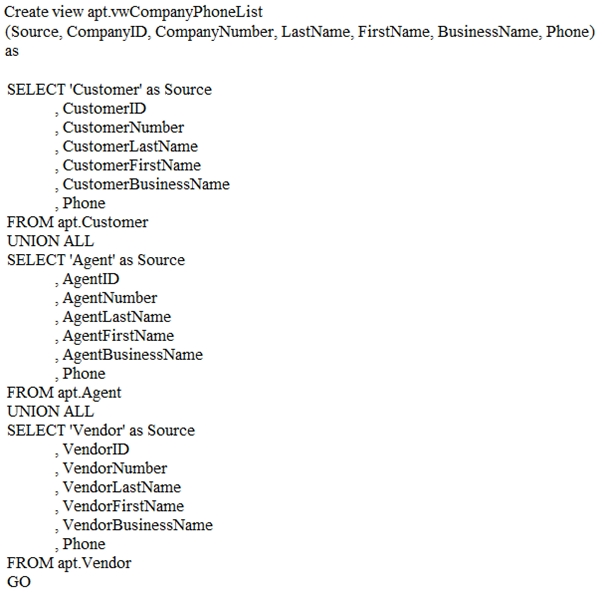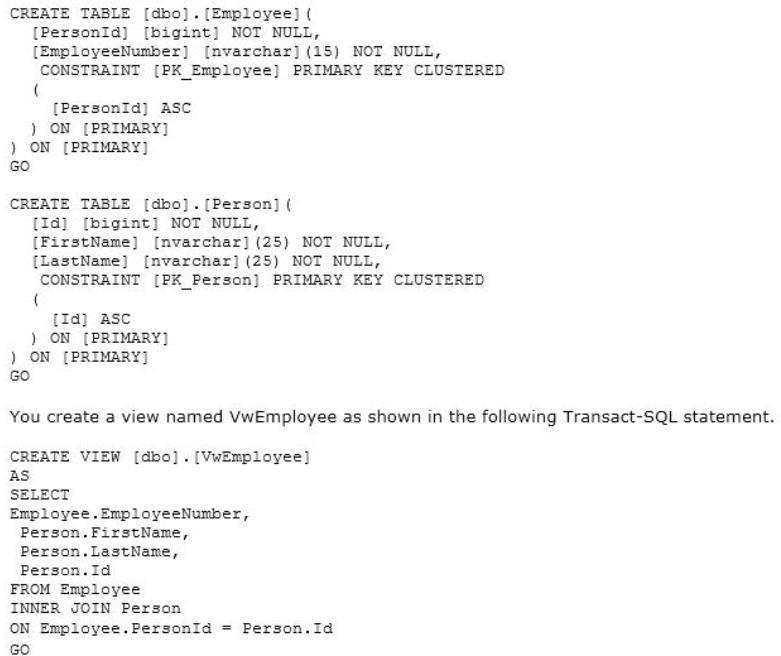Microsoft 70-461 Exam Practice Questions (P. 5)
- Full Access (265 questions)
- One Year of Premium Access
- Access to one million comments
- Seamless ChatGPT Integration
- Ability to download PDF files
- Anki Flashcard files for revision
- No Captcha & No AdSense
- Advanced Exam Configuration
Question #21
Note: This question is part of a series of questions that use the same set of answer choices. An answer choice may be correct for more than one question in the series.
You develop a database for a travel application. You need to design tables and other database objects.
You need to store media files in several tables.
Each media file is less than 1 MB in size. The media files will require fast access and will be retrieved frequently.
What should you do?
You develop a database for a travel application. You need to design tables and other database objects.
You need to store media files in several tables.
Each media file is less than 1 MB in size. The media files will require fast access and will be retrieved frequently.
What should you do?
- AUse the CAST function.
- BUse the DATE data type.
- CUse the FORMAT function.
- DUse an appropriate collation.
- EUse a user-defined table type.
- FUse the VARBINARY data type.
- GUse the DATETIME data type.
- HUse the DATETIME2 data type.
- IUse the DATETIMEOFFSET data type.
- JUse the TODATETIMEOFFSET function.
Correct Answer:
F
Reference:
http://msdn.microsoft.com/en-us/library/ms188362.aspx
F
Reference:
http://msdn.microsoft.com/en-us/library/ms188362.aspx
send
light_mode
delete
Question #22
Note: This question is part of a series of questions that use the same set of answer choices. An answer choice may be correct for more than one question in the series.
You develop a database for a travel application. You need to design tables and other database objects.
You create a view that displays the dates and times of the airline schedules on a report.
You need to display dates and times in several international formats.
What should you do?
You develop a database for a travel application. You need to design tables and other database objects.
You create a view that displays the dates and times of the airline schedules on a report.
You need to display dates and times in several international formats.
What should you do?
- AUse the CAST function.
- BUse the DATE data type.
- CUse the FORMAT function.
- DUse an appropriate collation.
- EUse a user-defined table type.
- FUse the VARBINARY data type.
- GUse the DATETIME data type.
- HUse the DATETIME2 data type.
- IUse the DATETIMEOFFSET data type.
- JUse the TODATETIMEOFFSET function.
Correct Answer:
C
Reference:
http://msdn.microsoft.com/en-us/library/hh213505.aspx
C
Reference:
http://msdn.microsoft.com/en-us/library/hh213505.aspx
send
light_mode
delete
Question #23
You are a database developer of a Microsoft SQL 2012 Server database.
You are designing a table that will store Customer data from different sources. The table will include a column that contains the CustomerID from the source system and a column that contains the SourceID.
A sample of this data is as shown in the following table.

You need to ensure that the table has no duplicate CustomerID within a SourceID. You also need to ensure that the data in the table is in the order of SourceID and then CustomerID.
Which Transact- SQL statement should you use?
You are designing a table that will store Customer data from different sources. The table will include a column that contains the CustomerID from the source system and a column that contains the SourceID.
A sample of this data is as shown in the following table.

You need to ensure that the table has no duplicate CustomerID within a SourceID. You also need to ensure that the data in the table is in the order of SourceID and then CustomerID.
Which Transact- SQL statement should you use?
- ACREATE TABLE Customer ( SourceID int NOT NULL IDENTITY, CustomerID int NOT NULL IDENTITY, CustomerName varchar(255) NOT NULL );
- BCREATE TABLE Customer ( SourceID int NOT NULL, CustomerID int NOT NULL PRIMARY KEY CLUSTERED, CustomerName varchar(255) NOT NULL );
- CCREATE TABLE Customer ( SourceID int NOT NULL PRIMARY KEY CLUSTERED, CustomerID int NOT NULL UNIQUE, CustomerName varchar(255) NOT NULL );
- DCREATE TABLE Customer ( SourceID int NOT NULL, CustomerID int NOT NULL, CustomerName varchar(255) NOT NULL, CONSTRAINT PK_Customer PRIMARY KEY CLUSTERED (SourceID, CustomerID) );
- ECREATE TABLE Customer ( SourceID int NOT NULL UNIQUE, CustomerID int NOT NULL UNIQUE, CustomerName varchar(255) NOT NULL );
Correct Answer:
D
A PRIMARY KEY is a constraint that enforces entity integrity for a specified column or columns by using a unique index. Only one PRIMARY KEY constraint can be created for each table.
We need to use both SourceID and CustomerID, in that order, in the PRIMARY KEY constraint.
References:
https://msdn.microsoft.com/en-us/library/ms188066.aspx
D
A PRIMARY KEY is a constraint that enforces entity integrity for a specified column or columns by using a unique index. Only one PRIMARY KEY constraint can be created for each table.
We need to use both SourceID and CustomerID, in that order, in the PRIMARY KEY constraint.
References:
https://msdn.microsoft.com/en-us/library/ms188066.aspx
send
light_mode
delete
Question #24
You have three tables that contain data for vendors, customers, and agents. You create a view that is used to look up telephone numbers for these companies.
The view has the following definition:

You need to ensure that users can update only the phone numbers by using this view.
What should you do?
The view has the following definition:

You need to ensure that users can update only the phone numbers by using this view.
What should you do?
- AAlter the view. Use the EXPAND VIEWS query hint along with each SELECT statement.
- BDrop the view. Re-create the view by using the SCHEMABINDING clause, and then create an index on the view.
- CCreate an AFTER UPDATE trigger on the view.
- DCreate an INSTEAD OF UPDATE trigger on the view.
Correct Answer:
D
Reference:
http://msdn.microsoft.com/en-us/library/ms187956.aspx
D
Reference:
http://msdn.microsoft.com/en-us/library/ms187956.aspx
send
light_mode
delete
Question #25
You develop a Microsoft SQL Server database that contains tables named Employee and Person.
The tables have the following definitions:

Users are able to use single INSERT statements or INSERT...SELECT statements into this view.
You need to ensure that users are able to use a single statement to insert records into both Employee and Person tables by using the VwEmployee view.
Which Transact-SQL statement should you use?
A.
CREATE TRIGGER TrgVwEmployee -
ON VwEmployee -
FOR INSERT -
AS -
BEGIN -
INSERT INTO Person(Id, FirstName, LastName)
SELECT Id, FirstName, LastName, FROM inserted
INSERT INTO Employee(PersonId, EmployeeNumber)
SELECT Id, EmployeeNumber FROM inserted
END -
B.
CREATE TRIGGER TrgVwEmployee -
ON VwEmployee -
INSTEAD OF INSERT -
AS -
BEGIN -
INSERT INTO Person(Id, FirstName, LastName)
SELECT Id, FirstName, LastName, FROM inserted
INSERT INTO Employee(PersonId, EmployeeNumber)
SELECT Id, EmployeeNumber FROM inserted
END -
CREATE TRIGGER TrgVwEmployee -
C.
ON VwEmployee -
INSTEAD OF INSERT -
AS -
BEGIN -
DECLARE @ID INT, @FirstName NVARCHAR(25), @LastName NVARCHAR(25),
@PersonID
INT, @EmployeeNumber NVARCHAR(15)
SELECT @ID = ID, @FirstName = FirstName, @LastName = LastName,
@EmployeeNumber = EmployeeNumber
FROM inserted -
INSERT INTO Person(Id, FirstName, LastName)
VALUES(@ID, @FirstName, @LastName)
INSERT INTO Employee(PersonID, EmployeeNumber)
VALUES(@PersonID, @EmployeeNumber
END -
D.
CREATE TRIGGER TrgVwEmployee -
ON VwEmployee -
INSTEAD OF INSERT -
AS -
BEGIN -
INSERT INTO Person(Id, FirstName, LastName)
SELECT Id, FirstName, LastName FROM VwEmployee
INSERT INTO Employee(PersonID, EmployeeNumber)
SELECT Id, EmployeeNumber FROM VwEmployee
END -
The tables have the following definitions:

Users are able to use single INSERT statements or INSERT...SELECT statements into this view.
You need to ensure that users are able to use a single statement to insert records into both Employee and Person tables by using the VwEmployee view.
Which Transact-SQL statement should you use?
A.
CREATE TRIGGER TrgVwEmployee -
ON VwEmployee -
FOR INSERT -
AS -
BEGIN -
INSERT INTO Person(Id, FirstName, LastName)
SELECT Id, FirstName, LastName, FROM inserted
INSERT INTO Employee(PersonId, EmployeeNumber)
SELECT Id, EmployeeNumber FROM inserted
END -
B.
CREATE TRIGGER TrgVwEmployee -
ON VwEmployee -
INSTEAD OF INSERT -
AS -
BEGIN -
INSERT INTO Person(Id, FirstName, LastName)
SELECT Id, FirstName, LastName, FROM inserted
INSERT INTO Employee(PersonId, EmployeeNumber)
SELECT Id, EmployeeNumber FROM inserted
END -
CREATE TRIGGER TrgVwEmployee -
C.
ON VwEmployee -
INSTEAD OF INSERT -
AS -
BEGIN -
DECLARE @ID INT, @FirstName NVARCHAR(25), @LastName NVARCHAR(25),
@PersonID
INT, @EmployeeNumber NVARCHAR(15)
SELECT @ID = ID, @FirstName = FirstName, @LastName = LastName,
@EmployeeNumber = EmployeeNumber
FROM inserted -
INSERT INTO Person(Id, FirstName, LastName)
VALUES(@ID, @FirstName, @LastName)
INSERT INTO Employee(PersonID, EmployeeNumber)
VALUES(@PersonID, @EmployeeNumber
END -
D.
CREATE TRIGGER TrgVwEmployee -
ON VwEmployee -
INSTEAD OF INSERT -
AS -
BEGIN -
INSERT INTO Person(Id, FirstName, LastName)
SELECT Id, FirstName, LastName FROM VwEmployee
INSERT INTO Employee(PersonID, EmployeeNumber)
SELECT Id, EmployeeNumber FROM VwEmployee
END -
send
light_mode
delete
All Pages
